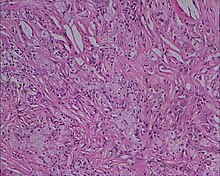Xanthoma
| Xanthoma | |
|---|---|
xanthoma tuberosum[1] | |
| Specialty | Gastroenterology, dermatology |
A xanthoma (pl. xanthomas or xanthomata) (condition: xanthomatosis) is a deposition of yellowish
Tendon xanthomas are associated with type II hyperlipidemia, chronic
Etymology
The term xanthoma stems from Greek ξανθός (xanthós) 'yellow', and -ωμα -oma, a suffix forming nouns indicating a mass or tumor.
Types
Xanthelasma

A
Xanthoma tuberosum
Xanthoma tuberosum (also known as tuberous xanthoma) is characterized by xanthomas located over tuberosity of the joints.[2]: 530
Xanthoma tendinosum
Xanthoma tendinosum (also tendon xanthoma or tendinous xanthoma[5]) is clinically characterized by papules and nodules found in the tendons of the hands, feet, and heel.[2]: 531 Also associated with familial hypercholesterolemia (FH).[6]
Eruptive xanthoma
Eruptive xanthoma (
Xanthoma planum
Xanthoma planum (
Palmar xanthoma
Palmar xanthoma is clinically characterized by yellowish plaques that involve the palms and flexural surfaces of the fingers.[2]: 531 Plane xanthomas are characterised by yellowish to orange, flat macules or slightly elevated plaques, often with a central white area which may be localised or generalised. They often arise in the skin folds, especially the palmar creases. They occur in hyperlipoproteinaemia type III and type IIA, and in association with biliary cirrhosis. The presence of palmar xanthomata, like the presence of tendinous xanthomata, is indicative of hypercholesterolaemia.[citation needed]
Tuberoeruptive xanthoma
Tuberoeruptive xanthoma (
Other types
Other types of xanthoma identified in the Medical Dictionary include:[8]
- Xanthoma diabeticorum: a type of eruptive xanthoma, often with severe diabetes.
- Xanthoma disseminatum: a rare xanthoma consisting of non-X histiocytes on flexural (folded) surfaces, associated with diabetes insipidus.
- Verrucous xanthoma, or histiocytes.
See also
References
- ^ PMID 18687118.
- ^ ISBN 978-0-7216-2921-6.
- ISBN 978-0-7817-7578-6.
- ^ thefreedictionary.com > xanthelasma Citing: The American Heritage Medical Dictionary Copyright 2007, 2004 and Mosby's Medical Dictionary, 8th edition. 2009
- ^ ISBN 978-1-4160-2999-1.
- PMID 9603797.
- PMID 21278899.
- ^ "Xanthoma". Medical Dictionary - Dictionary of Medicine and Human Biology. Retrieved 2015-02-05.
External links
 Media related to xanthoma at Wikimedia Commons
Media related to xanthoma at Wikimedia Commons- MedlinePlus Encyclopedia: Xanthoma
